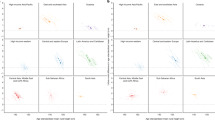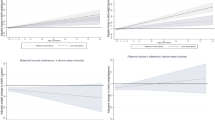Abstract
Objective: The aim of the study was to report the association of socio-economic factors with child's height.
Design: Cross-sectional study based on a representative national sample of government schools.
Setting: Trinidad and Tobago in 1999.
Subjects: A total of 2608 boys and girls mean age 5.8 y, range 4.38–6.99 y and 3080 mean age 8.6 y, range 7.00–10.44 y olds.
Outcome: Measurement of height and a questionnaire completed by parents. In the analysis height was expressed as standard deviation scores (s.d.s.) based on the British height curves (1990) or height below −1.5 s.d.s.
Results: Ethnicity, parental heights, birthweight, maternal age at child's birth and number of children in the family were the main factors associated with children's height. Lack of piped water supply in the home was the only socio-economic factor consistently associated with height (mean difference in s.d.s. adjusted only for age group, gender and ethnicity −0.192, 95% CI −0.257 to −0.127 and in addition adjusted for the variables listed above −0.080, 95% CI −0.141 to −0.019). Parental education, household overcrowding and employment status were weakly associated with height in the partially adjusted model only. Analysis of severe growth failure gave similar results.
Conclusion: The impact of socio-economic factors on height is marginal in Trinidad and Tobago. As socio-economic factors may have an impact on a broad range of health indicators, height and rates of undernutrition should not be used as sole criteria for assessing progress in decreasing health differentials caused by social inequalities.
Sponsorship: None.
This is a preview of subscription content, access via your institution
Access options
Subscribe to this journal
Receive 12 print issues and online access
$259.00 per year
only $21.58 per issue
Buy this article
- Purchase on Springer Link
- Instant access to full article PDF
Prices may be subject to local taxes which are calculated during checkout
Similar content being viewed by others
References
Amigo, H, Bustos, P, Leone, C & Radrigan, ME (2001). Growth deficits in Chilean school children. J. Nutr., 131, 251–254.
Belicki, T & Szklarska, A (1999). Secular trends in stature in Poland: national and social class-specific. Ann. Hum. Biol., 26, 251–258.
Cameron, N (1986). The methods of auxological anthropometry. In:Human Growth. A Comprehensive Treatise. Volume 3. Methodology, Ecological, Genetic, and Nutritional Effects on Growth, ed. F Falkner & JM Tanner, Chapter 1, pp3–46, New York: Plenum Press
Central Statistical Office, Republic of Trinidad and Tobago (1994). 1990 Population and Housing Census. Volume II. Age structure, Religion, Ethnic Group, Education, Port of Spain: Central Statistical Office, Office of the Prime Minister
Chinn, S, Hughes, JM & Rona, RJ (1998). Trends in growth and obesity in ethnic groups in Britain. Arch. Dis. Child., 78, 513–517.
Dowding, VM (1981). New assessment of the effects of birth order and socio-economic status on birth weight. Br. Med. J., 282, 683–686.
Freeman, JV, Cole, TJ, Chinn, S, Jones, PRM, White, EM & Preece, MA (1995). Cross sectional stature and weight reference curve for the UK, 1990. Arch. Dis. Child., 73, 17–24.
Garn, SM, Clark, DC & Trowbridge, FL (1973). Tendency toward greater stature in American black children. Am. J. Dis. Child., 126, 164–166.
Guimaraes, LV, Latorre, MD & Barros, MB (1999). Fatores de risco para a ocorrência de déficit em pré-escolares. Cadernos Saude Publica, 15, 605–615.
Gulliford, MC, Chinn, S & Rona, RJ (1991). Social environment and height: England and Scotland 1987 and 1988. Arch. Dis. Child., 66, 235–240.
Gulliford, MC & Mahabir, D (2001). Utilisation of private by public primary care clinic attenders with diabetes: relationship to health status and social factors. Soc. Sci. Med., 53, 1045–1056.
Gulliford, MC, Mahabir, D, Rocke, B, Chinn, S & Rona, R (2001). Overweight, obesity and skinfold thicknesses of children of African or Indian descent in Trinidad and Tobago. Int. J. Epidemiol., 30, 989–998.
Hernandez-Diaz, S, Peterson, KE, Dixit, S, Hernandez, B, Parra, S, Sepulveda, J & Rivera, JA (1999). Association of maternal short stature with stunting in Mexican children: common genes vs common environment. Eur. J. Clin. Nutr., 53, 938–945.
Herngreen, WP, Van Buuren, S, Van Wieringen, JC, Reerink, JD, Verloove-VanHorick, SP & Ruys, JH (1994). Growth in length and weight from birth to 2 y of a representative sample of the Netherlands children (born in 1988–89) related to socio-economic status and other background characteristics. Ann. Hum. Biol., 21, 449–463.
Jordan, J, Ruben, M, Hernandez, J, Bebelagua, A, Tanner, JM & Goldstein, H (1975). The 1972 Cuban national growth study as an example of population health monitoring: design and methods. Ann. Hum. Biol., 2, 153–171.
Lindgren, G (1976). Height, weight and menarche in Swedish school children in relation to socio-economic and regional factors. Ann. Hum. Biol., 3, 501–528.
Martorell, R & Habicht, J-P (1986). Growth in early childhood in developing countries. In:Human Growth. A Comprehensive Treatise. Volume 3. Methodology, Ecological, Genetic, and Nutritional Effects on Growth, 2nd edn, ed. F Falkner & JM Tanner, Chapter 12, pp241–262, London: Plenum Press
Mueller, WH (1976). Parent–child correlation for stature and weight and weight among school aged children: a review of 24 studies. Hum. Biol., 48, 379–397.
Nebigil, I, Hizel, S, Tanyer, G, Dallar, Y & Coskun, T (1997). Heights and weights of primary school children of different social background in Ankara, Turkey. J. Trop. Pediat., 43, 297–300.
Northrop-Clewes, CA, Rousahm, EK, Mascie-Taylor, CN & Lunn, PG (2001). Antihelminthic treatment of rural Bangladeshi children: effect on host physiology, growth, and biochemical status. Am. J. Clin. Nutr., 73, 53–60.
Padez, C & Johnston, F (1999). Secular trend in male adult height 1904-1996 in relation to place of residence and parent's educational level in Portugal. Ann. Hum. Biol., 26, 287–298.
Reading, R, Raybould, S & Jarvis, S (1993). Deprivation, low birth weight, and children's height: a comparison between rural and urban areas. Br. Med. J., 307, 1458–1462.
Rona, RJ (2000). The impact of the environment on height in Europe: conceptual and theoretical considerations. Ann. Hum. Biol., 27, 111–126.
Rona, RJ & Altman, DG (1977). National Study of Health and Growth: Standards of attained height, weight and triceps skinfold in English children 5 to 11 y old. Ann. Hum. Biol., 4, 501–523.
Shen, T, Habicht, J-P & Chang, Y (1996). Effect of economic reforms on child growth in urban and rural areas of China. New Engl. J. Med., 335, 400–406.
Simeon, DT, Grantham-McGregor, SM, Callender, JE & Wong, MS (1995). Treatment of Trichuris trichiura infections improves growth, spelling scores and school attendance in some children. J. Nutr., 125, 1875–1883.
Sinha, DP (1988). Children of the Caribbean 1945–1984. Progress in Child Survival, its Determinants and Implications, Kingston, Jamaica: Caribbean Food and Nutrition Institute (PAHO/WHO)
Stata Corporation (1999). Stata Release 6. Volume 3. Su-Z, pp420–440, College Station, Txs: Stata Press
Stephensen, CB (1999). Burden of infection on growth failure. J. Nutr., 129, (2S Suppl) 534S–538S.
Tanner, JM (1986). Growth as a mirror of the condition of society: secular trends and class distinctions. In:Human Growth. A Multidisciplinary Review, ed. A Demirjian, pp3–34, London: Taylor & Francis
Torres, AM, Peterson, KE, de Souza, AC, Orav, EJ, Hughes, M & Chen, LC (2000). Association of diarrhoea and upper respiratory infections with height and height gains in Bangladeshi children aged 5 to 11 y. Bull WHO, 78, 1316–1323.
United Nations Development Programme (2000). Human Development Indicators, www.undp.org/hdr2000/english/book/back1.pdf (accessed 11 August 2000)
Voss, LD, Mulligan, J & Betts, PR (1998). Short stature at school entry—an index of social deprivation? (The Wessex Growth study). Child Care Health Devl., 24, 145–156.
World Bank (2001). www.worldbank.org/data/databytopic/databytopic.html (accessed 28 June 2001)
Wong, MS, Simeon, DT, Powell, CA & Grantham-McGregor, SM (1994). Geohelminth infections in school-aged children in Jamaica. West Ind. Med. J., 43, 121–122.
Acknowledgements
The authors thank the Chief Medical Officer of Trinidad and Tobago for permission to report this work. They also thank the Principal Medical Officer (Community Services), the Ministry of Education, and the staff, pupils and parents of the participating schools for their support of the survey. Special thanks are due to the staff of the Nutrition Division for their skill and dedication in working on the survey.
Author information
Authors and Affiliations
Corresponding author
Rights and permissions
About this article
Cite this article
Rona, R., Mahabir, D., Rocke, B. et al. Social inequalities and children's height in Trinidad and Tobago. Eur J Clin Nutr 57, 143–150 (2003). https://doi.org/10.1038/sj.ejcn.1601508
Received:
Revised:
Accepted:
Published:
Issue Date:
DOI: https://doi.org/10.1038/sj.ejcn.1601508
Keywords
This article is cited by
-
Parents Living with HIV in China: Family Functioning and Quality of Life
Journal of Child and Family Studies (2009)



